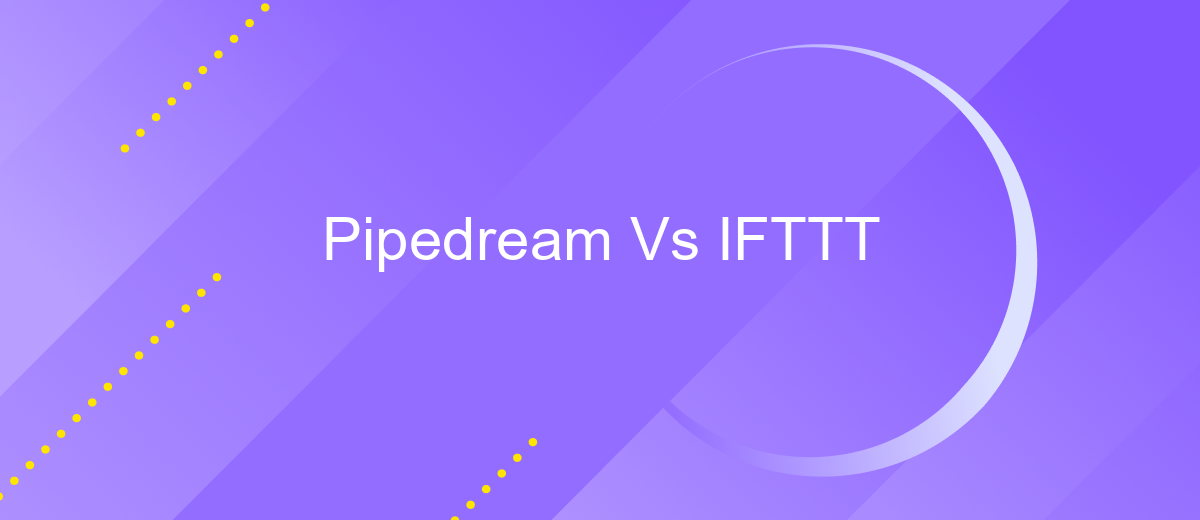Pipedream Vs IFTTT
In the rapidly evolving landscape of automation tools, Pipedream and IFTTT stand out as two prominent platforms catering to diverse user needs. While both aim to streamline workflows and enhance productivity, they offer distinct features and capabilities. This article delves into a comparative analysis of Pipedream and IFTTT, helping you determine which tool best aligns with your specific automation requirements.
Introduction
In today's digital age, automation tools are essential for streamlining workflows and enhancing productivity. Two popular platforms in this space are Pipedream and IFTTT. Both services offer unique features and capabilities that cater to different automation needs, making it crucial to understand their strengths and limitations.
- Pipedream: A powerful integration platform for developers, offering extensive customization and flexibility.
- IFTTT: A user-friendly automation tool designed for non-technical users, providing simple and straightforward integrations.
Choosing the right platform depends on your specific requirements and technical expertise. For instance, if you need a more developer-centric solution with advanced customization options, Pipedream might be the better choice. On the other hand, if you prefer a more accessible and easy-to-use tool, IFTTT could be more suitable. Additionally, services like ApiX-Drive can further enhance your integration capabilities by providing seamless connections between various applications and platforms.
Key Differences

Pipedream and IFTTT are both powerful automation tools, but they cater to different user needs. Pipedream is designed for developers and technical users, offering extensive customization and coding capabilities. It allows users to write custom scripts in JavaScript, Python, and other languages, enabling complex workflows and integrations. In contrast, IFTTT targets a broader audience with its user-friendly interface, making it easy for non-technical users to create simple automations using a wide range of pre-built applets and services.
Another key difference lies in their integration capabilities. Pipedream supports a vast array of APIs and services, giving users the flexibility to connect virtually any application or service. This makes it ideal for businesses and developers who need advanced integrations and custom workflows. On the other hand, IFTTT focuses on simplicity, offering a more limited but highly curated set of integrations that cover popular consumer apps and smart home devices. For those who need a balance between ease of use and powerful integrations, services like ApiX-Drive provide a middle ground, offering user-friendly interfaces with robust integration options.
Pricing

When comparing Pipedream and IFTTT in terms of pricing, it's essential to consider the different tiers and what each platform offers at various price points. Both platforms provide a range of options to cater to different user needs, from individual hobbyists to large enterprises.
- Pipedream offers a free tier with limited executions, ideal for small projects or testing. For more extensive usage, their paid plans start at /month, providing increased executions and additional features like custom domains and priority support.
- IFTTT also has a free plan that allows users to create up to three applets. Their Pro plan, priced at .99/month, offers unlimited applets, faster execution times, and advanced filtering options.
For users seeking more robust integration capabilities, ApiX-Drive is a viable alternative. It offers a flexible pricing model based on the number of integrations and tasks, making it a cost-effective choice for businesses needing scalable automation solutions. Ultimately, the best platform for you will depend on your specific requirements and budget.
Use Cases

When it comes to automation, both Pipedream and IFTTT offer unique advantages tailored to different needs. Pipedream is ideal for developers who require extensive customization and integration capabilities, while IFTTT is perfect for users looking for simple, pre-built applets to automate everyday tasks.
For businesses and individuals, these platforms can streamline workflows and boost productivity. Pipedream allows for complex, multi-step workflows that can integrate with various APIs, making it suitable for tech-savvy users. On the other hand, IFTTT provides an easy-to-use interface for setting up basic automations without any coding knowledge.
- Automating social media posts
- Syncing data between different applications
- Monitoring and alerting systems
- Creating custom notifications for specific events
Additionally, services like ApiX-Drive can further enhance your automation setup by providing seamless integration between different platforms. Whether you choose Pipedream or IFTTT, incorporating ApiX-Drive can help you achieve a more robust and efficient workflow, tailored to your specific needs.
Conclusion
In conclusion, both Pipedream and IFTTT offer robust solutions for automating workflows, each catering to different needs and levels of technical expertise. Pipedream shines with its flexibility and powerful developer-centric features, making it ideal for those who require extensive customization and are comfortable with coding. On the other hand, IFTTT excels in simplicity and ease of use, making it accessible to a broader audience who need straightforward automation without diving into complex configurations.
For users looking for a middle ground, services like ApiX-Drive can provide an excellent alternative. ApiX-Drive offers a user-friendly interface while supporting a wide array of integrations, making it easier to connect various applications and automate tasks without needing in-depth technical knowledge. Ultimately, the choice between Pipedream, IFTTT, and other integration services like ApiX-Drive depends on your specific requirements, technical skills, and the complexity of the automation you aim to achieve.
- Automate the work of an online store or landing
- Empower through integration
- Don't spend money on programmers and integrators
- Save time by automating routine tasks
FAQ
What are the main differences between Pipedream and IFTTT?
Can I use these platforms for business automation?
How do Pipedream and IFTTT handle integrations with other apps?
Are there any limitations on the number of automations I can create?
Which platform is more suitable for non-developers?
Time is the most valuable resource for business today. Almost half of it is wasted on routine tasks. Your employees are constantly forced to perform monotonous tasks that are difficult to classify as important and specialized. You can leave everything as it is by hiring additional employees, or you can automate most of the business processes using the ApiX-Drive online connector to get rid of unnecessary time and money expenses once and for all. The choice is yours!


